 W
WGiovanni Andrea Ansaldo was an Italian painter active mainly in Genoa.
 W
WJacopo de' Barbari, sometimes known or referred to as de'Barbari, de Barberi, de Barbari, Barbaro, Barberino, Barbarigo or Barberigo, was an Italian painter, printmaker and miniaturist with a highly individual style. He moved from Venice to Germany in 1500, thus becoming the first Italian Renaissance artist of stature to work in Northern Europe. His few surviving paintings include the first known example of trompe-l'œil since antiquity. His twenty-nine engravings and three very large woodcuts were also highly influential.
 W
WJulian Beever is a British sidewalk chalk artist who has been creating trompe-l'œil chalk drawings on pavement surfaces since the mid-1990s. He uses a projection technique called anamorphosis to create the illusion of three dimensions when viewed from the correct angle. He preserves his work in photographs, often positioning a person within the image as if they were interacting with the scene.
 W
WJacob Biltius or Jacobus Biltius was a Dutch still life painter originally from The Hague who worked in various places including The Hague, Amsterdam, Maastricht, Antwerp, Leeuwarden and Bergen op Zoom. He was known for his game still lifes, kitchen still lifes and trompe-l'œil still lifes.
 W
WCornelis Bisschop, was a Dutch Golden Age painter.
 W
WAaron Bohrod was an American artist best known for his trompe-l'œil still-life paintings.
 W
WHenri Cornelis Bol was a Dutch still life painter, whose work was known for its realism and trompe-l'œil technique.
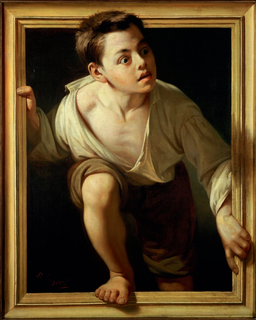 W
WPere Borrell del Caso was a Spanish painter, illustrator and engraver, known for his trompe-l'œil paintings; especially Escaping Criticism (1874).
 W
WJefferson David Chalfant was an American painter who is remembered mostly for his trompe-l'œil still life paintings.
 W
WEvert Collier was a Dutch Golden Age still-life painter known for vanitas and trompe-l'œil paintings. His first name is sometimes spelled "Edward" or "Edwaert" or "Eduwaert" or "Edwart," and his last name is sometimes spelled "Colyer" or "Kollier".
 W
WCarlo Crivelli was an Italian Renaissance painter of conservative Late Gothic decorative sensibility, who spent his early years in the Veneto, where he absorbed influences from the Vivarini, Squarcione, and Mantegna. He left the Veneto by 1458 and spent most of the remainder of his career in the March of Ancona, where he developed a distinctive personal style that contrasts with that of his Venetian contemporary Giovanni Bellini.
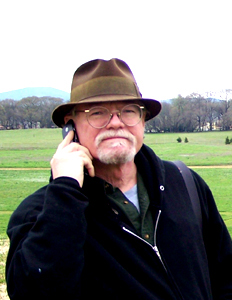 W
WRobert Dafford is an American muralist.
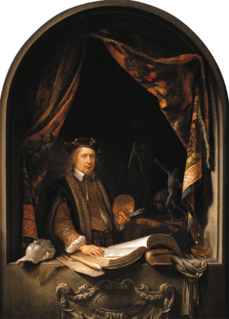 W
WGerrit Dou, also known as Gerard Douw or Dow, was a Dutch Golden Age painter, whose small, highly polished paintings are typical of the Leiden fijnschilders. He specialised in genre scenes and is noted for his trompe-l'œil "niche" paintings and candlelit night-scenes with strong chiaroscuro. He was a student of Rembrandt.
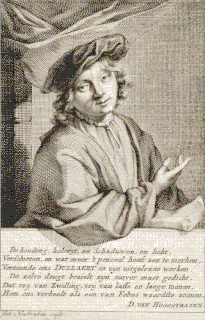 W
WHeyman Dullaert or Dullaart was a Dutch Golden Age painter and poet.
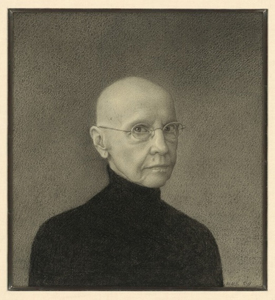 W
WMartha Mayer Erlebacher was an American painter. She attended Gettysburg College from 1955 to 1956. She received a BA in Industrial Design from the Pratt Institute. She also received an MFA from Pratt in 1963. She is known for her trompe-l'œil still lifes and well as her representational figurative work of the nude body. She was influenced by eighteenth- and nineteenth-century Italian and French painting traditions and well as by the realist Thomas Eakins.
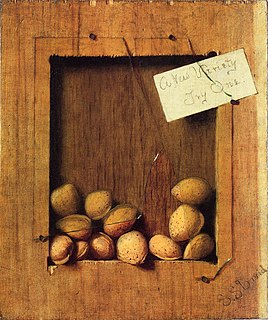 W
WDe Scott Evans was an American painter known for working in a number of genres. Raised in Indiana, he spent much of his career in Ohio and then moved to New York City. His posthumous reputation is largely based on a number of trompe-l'œil still lifes that have been attributed to him.
 W
WLaurent Geedts was a Flemish still life painter active in Leuven. He is known for his trompe-l'œil still lifes of game birds.
 W
WCornelis Norbertus Gijsbrechts or Gysbrechts was a Flemish painter who was active in the Spanish Netherlands, Germany, Denmark and Sweden in the second half of the seventeenth century. He was a court painter to the Danish royal family. He specialised in trompe-l'œil still lifes, an artistic genre which uses visual tricks to give viewers the illusion that they are not looking at a painting but rather at real three-dimensional objects. He also created many vanitas still lifes.
 W
WRichard La Barre Goodwin, also known as LaBarre Goodwin, was an American trompe-l'œil painter best known for his depictions of cabin doors, but also active in portraits and still lives of fruit, flowers, and kitchen scenes.
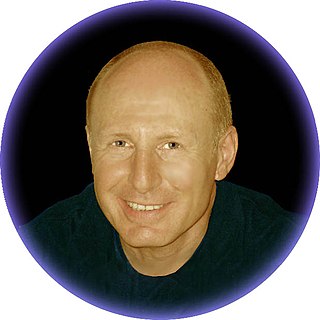 W
WFrédéric Gracia is a French artist, who is known for his trompe-l'œil murals, often in a hyperrealistic style and often on large exterior surfaces such as water towers and industrial chimneys. He calls himself a peintre-alpiniste (climber-painter) because he uses rope access techniques such as rappelling to create large outdoor murals.
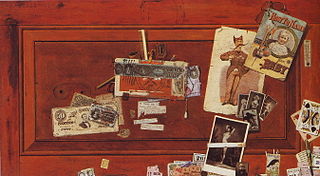 W
WJohn Haberle (1856–1933) was an American painter in the trompe-l'œil style. His still lifes of ordinary objects are painted in such a way that the painting can be mistaken for the objects themselves. He is considered one of the three major figures—together with William Harnett and John F. Peto—practicing this form of still life painting in the United States in the last quarter of the 19th century.
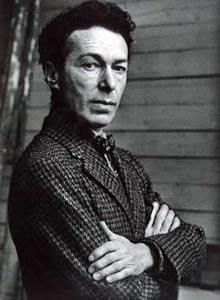 W
WHananiah Harari was an American painter and illustrator.
 W
WWilliam Michael Harnett was an Irish-American painter known for his trompe-l'œil still lifes of ordinary objects.
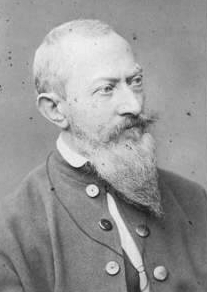 W
WJohann Friedrich Andreas Heimerdinger was a German painter; specializing in still-lifes.
 W
WClaude Raguet Hirst was an American painter of still lifes. She was the only woman of her era to gain acclaim using the trompe-l'œil technique.
 W
WNicola or Nicolino or Niccolino van Houbraken, also known as Nicolino Vanderbrach da Messina and Nicola Messinese was an Italian painter of the late-Baroque who was of Flemish descent. He specialized in paintings depicting playful arrangements of fruits, vegetables, vegetation, animals, game in interiors or in forests. He also painted allegories and garland paintings. His work was appreciated by the Medici court in Florence.
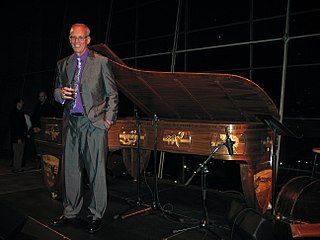 W
WSilas Kopf is an American furniture maker specializing in the art of marquetry. Kopf graduated from Princeton University in 1972 with a degree in architecture and soon began designing and making furniture. In 1988, he received a Craftsman's Fellowship from the National Endowment for the Arts, and used the opportunity to study traditional marquetry technique at the École Boulle, an institute of interior architecture and design, in Paris. His major projects include several pianos commissioned by Steinway & Sons and benches, desks, and cabinets for private collections and museums. His designs frequently incorporate floral depictions, other images from nature, and trompe-l'œil concepts. He first became interested in marquetry because he hoped for an alternative, less consumerist lifestyle.
 W
WGerard or Gérard (de) Lairesse was a Dutch Golden Age painter and art theorist. His broad range of skills included music, poetry, and theatre. De Lairesse was influenced by the Perugian Cesare Ripa and French classicist painters such as Charles le Brun, Simon Vouet and authors such as Pierre Corneille and Jean Racine. His importance grew in the period following the death of Rembrandt. His treatises on painting and drawing, Grondlegginge Ter Teekenkonst (1701), based on geometry and Groot Schilderboek (1707), were highly influential on 18th-century painters.
 W
WRainer Maria Latzke is a German artist working in the field of trompe-l'œil and mural painting. He taught at the Utah State University and is founder of the Institute of Frescography. Latzke is Honorary Professor of the Fudan University, Shanghai and Guest Professor of the Shanghai Institute of Visual Art . Latzke was ranked one of the 12 cultural trendsetters of the 1990s by Forbes and one of the world's best artists of the last four centuries by the Artists Trade Union of Russia. He is a cousin of Poland´s wealthiest entrepreneur Jan Kulczyk.
 W
WCornelis van der Meulen or Cornelis Vermeulen, was a Dutch painter who after training in the Dutch Republic had a career in Sweden where he became a court painter. He is known for still lifes of flowers and game, trompe-l'œil and vanitas still lifes, topographical views and portraits.
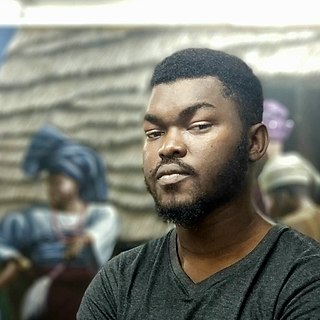 W
WBabajide Olatunji is a self-taught contemporary, expressionist Nigerian artist. He is mostly known for his Tribal Mark Series, which are a hyperrealistic series of portraits with facially scarified characters. His works are often markers of Yoruba cultural significance and socio-cultural discourse. He specializes in hyperrealism and trompe-l'œil art forms.
 W
WDavid Payne was a Scottish landscape painter.
 W
WCharles Willson Peale was an American painter, soldier, scientist, inventor, politician and naturalist. He is best remembered for his portrait paintings of leading figures of the American Revolution, and for establishing one of the first museums in the United States.
 W
WRaphaelle Peale is considered the first professional American painter of still-life.
 W
WGeorg Pencz was a German engraver, painter and printmaker.
 W
WJohn Frederick Peto was an American trompe-l'œil painter who was long forgotten until his paintings were rediscovered along with those of fellow trompe-l'œil artist William Harnett.
 W
WJacobus Plasschaert or Jacob Plasschaert, spelling variation of name Plasgaert was a Flemish painter and teacher. He is known for his trompe-l'œil still lifes and vanitas still lifes. He was active in Bruges.
 W
WAlexander Pope Jr. was an American artist, both in paint and wood carving, mostly of sporting and still life subjects. He was born in Dorchester, Massachusetts and died in Boston, Massachusetts. He studied for a short time under the sculptor William Copley, and was one of America's popular gaming artists.
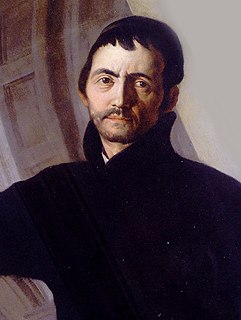 W
WAndrea Pozzo was an Italian Jesuit brother, Baroque painter, architect, decorator, stage designer, and art theoretician.
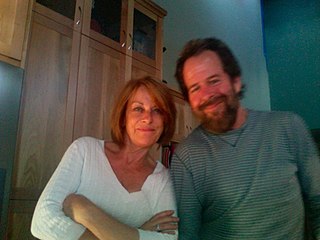 W
WJohn Pugh is an American artist known for creating large trompe-l'œil wall murals giving the illusion of a three-dimensional scene behind the wall. Pugh has been creating his murals since the late 1970s. He attended California State University Chico, receiving his BA in 1983 and the Distinguished Alumni Award in 2003. He has received over 250 public and private commissions in the United States, Canada, Mexico, Barbados, Japan, Taiwan, and New Zealand. He currently lives and works in Truckee, California. His particular style of trompe-l'œil painting has been called "Narrative Illusionism."
 W
WPetrus Norbertus van Reysschoot or Pieter Norbert van Reysschoot was a Flemish painter, draughtsman, decorator, educator and art collector. He spent his career in Ghent. He is known for his decorative projects in local residences and churches and in particular his grisaille paintings. His subject matter ranged from landscapes, allegories, mythological and religious stories, genre scenes and trompe-l'œil still lifes.
 W
WJacques Rousseau was a French painter.
 W
WPierre-Marie Rudelle was a French artist painter who specialized in trompe-l'œil. He was commissioned by Jacqueline Kennedy to paint a pair of doors in her dressing room in the White House. He died at Paris on 28 December 2015 at the age of 83 years.
 W
WAbbey Ryan is a contemporary American painter and educator, best known for her representational, classical realism still life and trompe-l'œil paintings. Her work is inspired by 17th century Dutch still life painting. She lives and works in Philadelphia, Pennsylvania.
 W
WPiat Joseph Sauvage or Pieter Joseph Sauvage was a painter, sculptor, printmaker and academic lecturer from the Southern Netherlands. He was known for his decorative paintings of interiors, grisailles and miniatures using trompe l'oeil effects as well as his small-scale portrait carvings. He often used precious materials such as marble, porcelain and ivory as the support for his paintings. He was a court painter to the governor of the Southern Netherlands, the Prince de Condé and the French king Louis XVI and a member of the Académie royale de peinture et de sculpture.
 W
WGregorio Sciltian was an Italian-Armenian painter, designer, and medallist. Sciltian is well known for his portraiture and trompe-l'œil compositions.
 W
WZachary Selig was an American artist, author, interior designer and celebrity spiritist.
 W
WJan van der Vaart or Jan van der Vaardt was a Dutch painter and draughtsman of portraits, landscapes and trompe-l'œil paintings and a mezzotint artist who was active in England for most of his career. He was also an art restorer and art collector.
 W
WPaolo Caliari, known as Paolo Veronese, was an Italian Renaissance painter based in Venice, known for extremely large history paintings of religion and mythology, such as The Wedding at Cana (1563) and The Feast in the House of Levi (1573). Included with Titian, a generation older, and Tintoretto, a decade senior, Veronese is one of the "great trio that dominated Venetian painting of the cinquecento" and the Late Renaissance in the 16th century. Known as a supreme colorist, and after an early period with Mannerism, Paolo Veronese developed a naturalist style of painting, influenced by Titian.
 W
WKurt Wenner is an American artist, he is known for his 3D pavement art shown internationally.
 W
WZamor, born on March 8, 1951 in Colombia, is a Colombian and French painter, sculptor and writer. He became known for his large paintings and the treatment of his male and female subjects using a technique between realism and hyperrealism.
 W
WTavar Zawacki formerly known as 'ABOVE' is an American abstract artist living and working between Lisbon, Portugal, and Bali, Indonesia. For twenty years (1996–2016) Tavar Zawacki created and signed all of his artworks with his street artist pseudonym, 'ABOVE'. Tavar was born and raised in California until the age of 19, at which time, Zawacki bought a one-way flight from California to Paris, France, bringing with him a backpack full of art supplies, all the money in his bank account, and a 'rise above your fears' approach to starting his art career. Starting in Paris in 2000, Tavar transitioned from painting traditional letter style graffiti of A-B-O-V-E, to his 'Above arrow' icon that represented his optimistic mentality to 'rise above fears, challenges, and anything holding you back from your goals.' During a 20-year period, the artworks of ABOVE could be seen in over 100 cities spanning 50 countries around the world.